Page 665 of 788
6657-2. Steps to take in an emergency
UK_AURIS/AURIS_HV_EE (OM12G88E)
7
When trouble arises
Turn the tire jack portion “A” by
hand until the notch of the jack
is in contact with the jack point.
The jack point guides are located
under the rocker panel. They indi-
cate the jack point positions.
Raise the vehicle until the tire is slightly raised off the ground.
Remove all the wheel nuts and
the tire.
When resting the tire on the
ground, place the tire so that the
wheel design faces up to avoid
scratching the wheel surface.
4
5
Vehicles with a compact spare
tireVehicles with a full-size spare
tire
6
Page 668 of 788
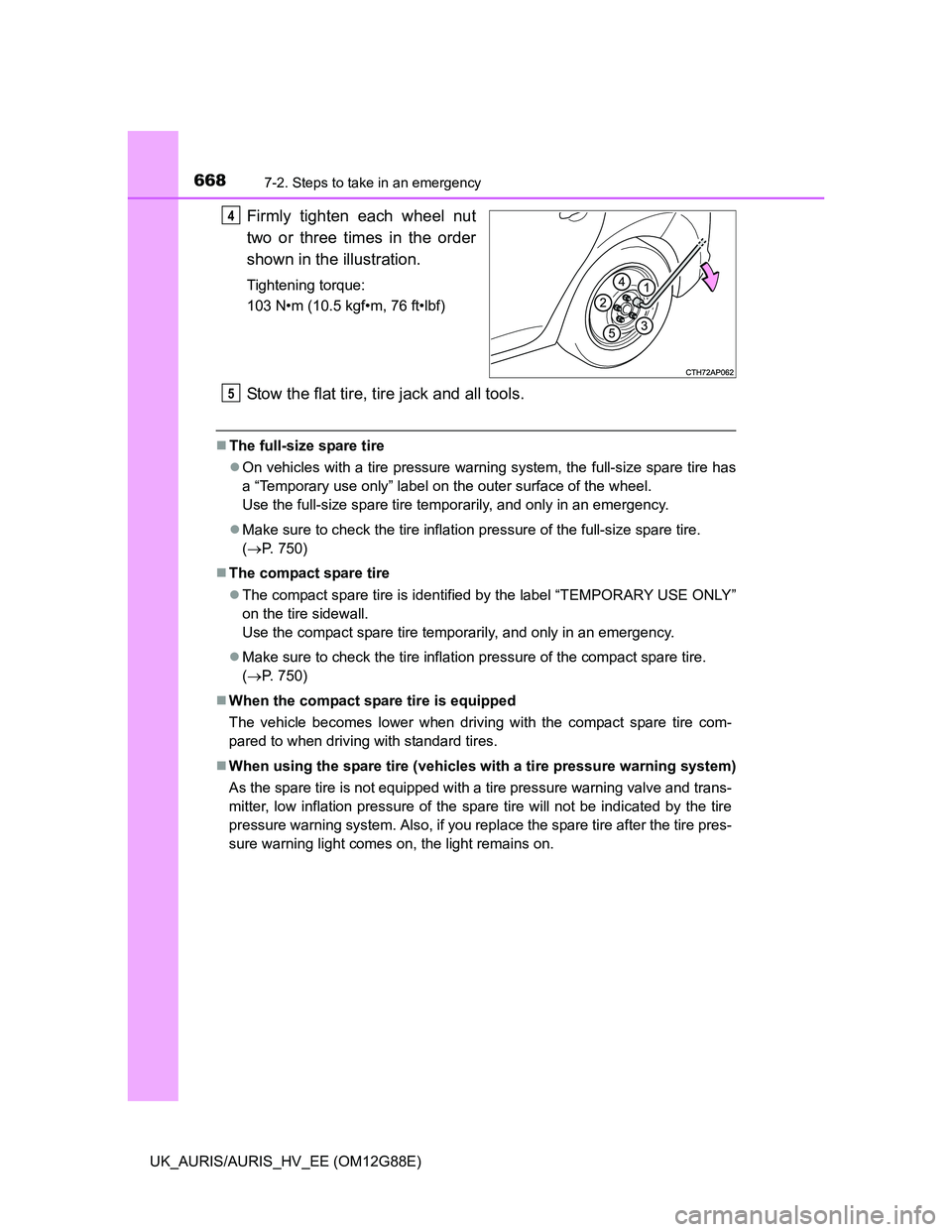
6687-2. Steps to take in an emergency
UK_AURIS/AURIS_HV_EE (OM12G88E)
Firmly tighten each wheel nut
two or three times in the order
shown in the illustration.
Tightening torque:
103 N•m (10.5 kgf•m, 76 ft•lbf)
Stow the flat tire, tire jack and all tools.
The full-size spare tire
On vehicles with a tire pressure warning system, the full-size spare tire has
a “Temporary use only” label on the outer surface of the wheel.
Use the full-size spare tire temporarily, and only in an emergency.
Make sure to check the tire inflation pressure of the full-size spare tire.
(P. 750)
The compact spare tire
The compact spare tire is identified by the label “TEMPORARY USE ONLY”
on the tire sidewall.
Use the compact spare tire temporarily, and only in an emergency.
Make sure to check the tire inflation pressure of the compact spare tire.
(P. 750)
When the compact spare tire is equipped
The vehicle becomes lower when driving with the compact spare tire com-
pared to when driving with standard tires.
When using the spare tire (vehicles with a tire pressure warning system)
As the spare tire is not equipped with a tire pressure warning valve and trans-
mitter, low inflation pressure of the spare tire will not be indicated by the tire
pressure warning system. Also, if you replace the spare tire after the tire pres-
sure warning light comes on, the light remains on.
4
5
Page 698 of 788
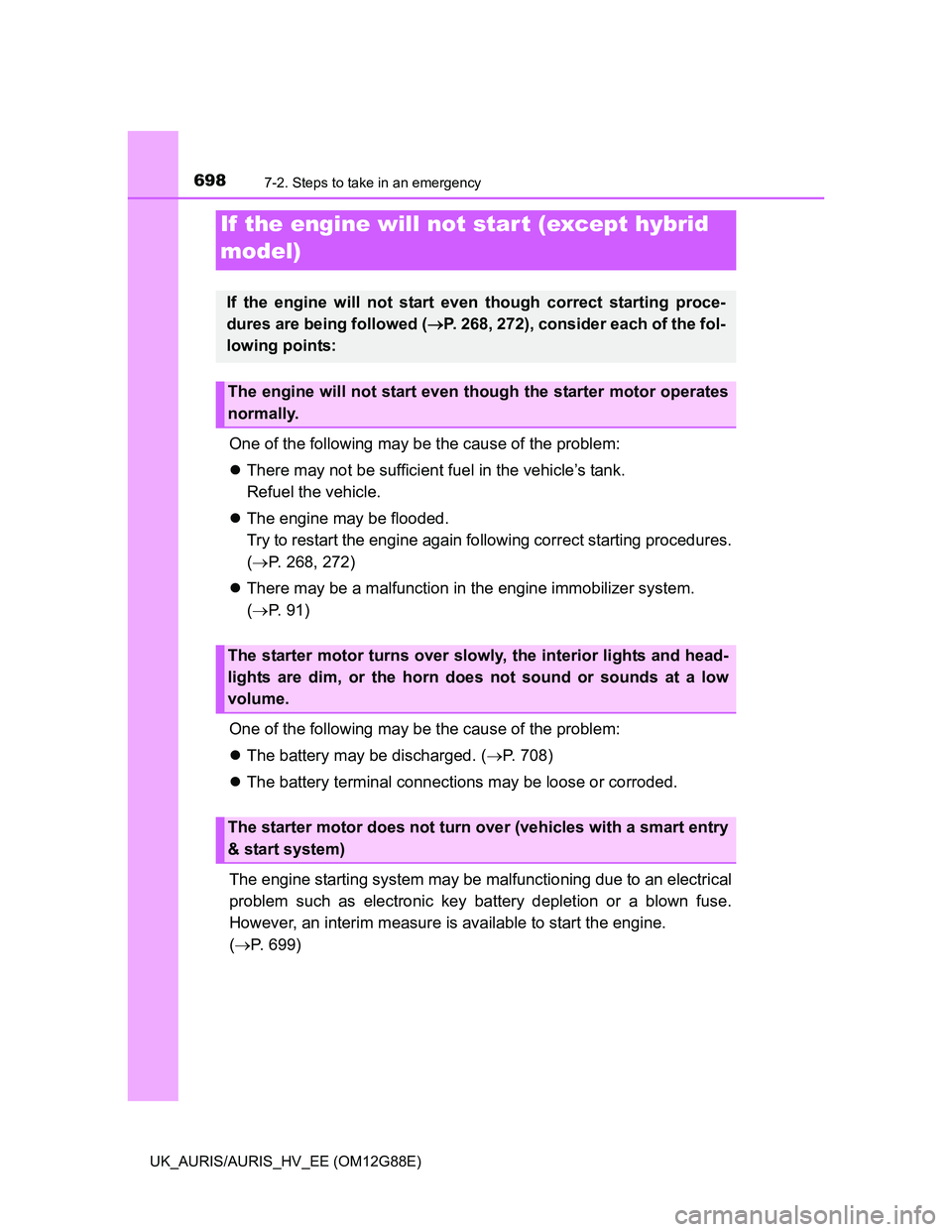
6987-2. Steps to take in an emergency
UK_AURIS/AURIS_HV_EE (OM12G88E)
One of the following may be the cause of the problem:
There may not be sufficient fuel in the vehicle’s tank.
Refuel the vehicle.
The engine may be flooded.
Try to restart the engine again following correct starting procedures.
(P. 268, 272)
There may be a malfunction in the engine immobilizer system.
(P. 91)
One of the following may be the cause of the problem:
The battery may be discharged. (P. 708)
The battery terminal connections may be loose or corroded.
The engine starting system may be malfunctioning due to an electrical
problem such as electronic key battery depletion or a blown fuse.
However, an interim measure is available to start the engine.
(P. 699)
If the engine will not start (except hybrid
model)
If the engine will not start even though correct starting proce-
dures are being followed (P. 268, 272), consider each of the fol-
lowing points:
The engine will not start even though the starter motor operates
normally.
The starter motor turns over slowly, the interior lights and head-
lights are dim, or the horn does not sound or sounds at a low
volume.
The starter motor does not turn over (vehicles with a smart entry
& start system)
Page 699 of 788
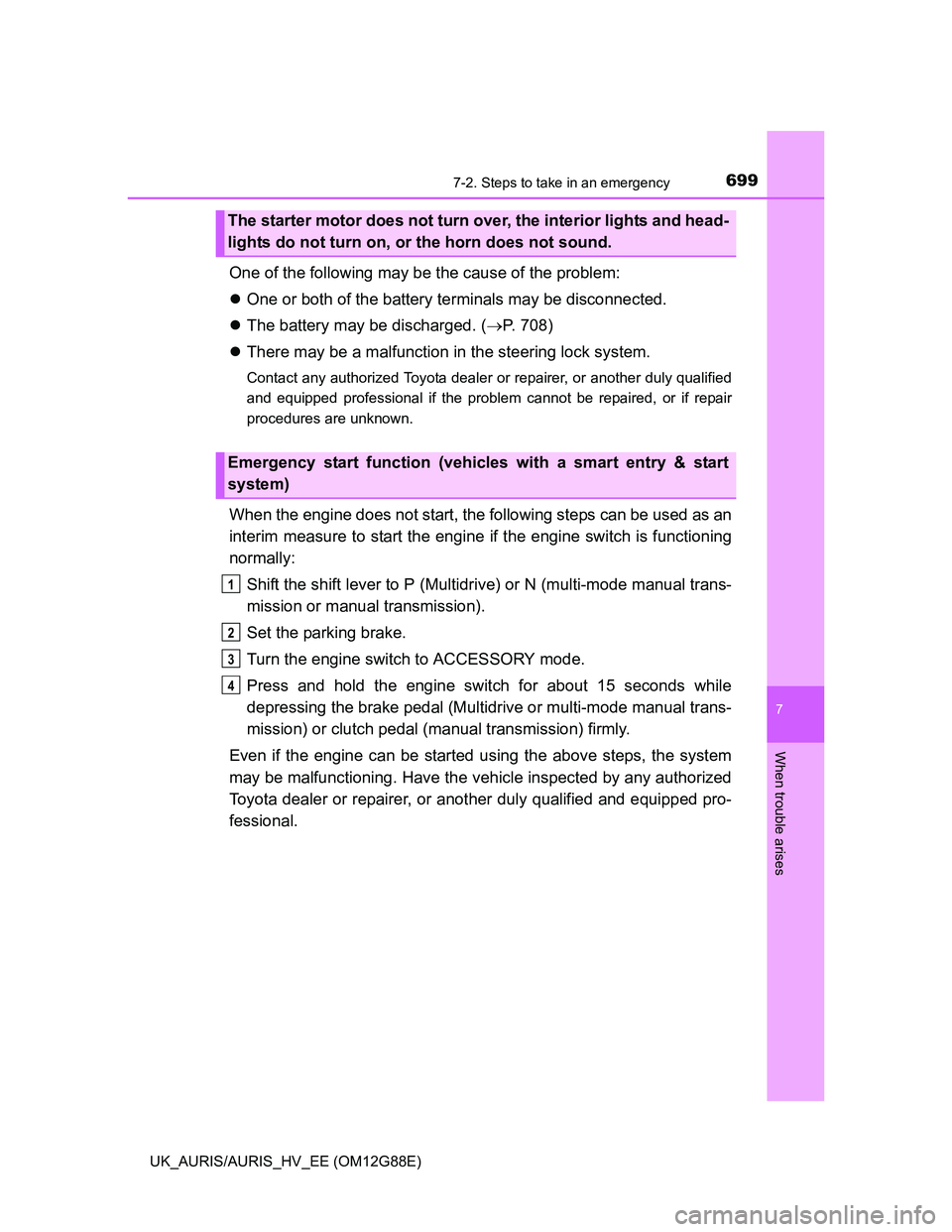
6997-2. Steps to take in an emergency
UK_AURIS/AURIS_HV_EE (OM12G88E)
7
When trouble arises
One of the following may be the cause of the problem:
One or both of the battery terminals may be disconnected.
The battery may be discharged. (P. 708)
There may be a malfunction in the steering lock system.
Contact any authorized Toyota dealer or repairer, or another duly qualified
and equipped professional if the problem cannot be repaired, or if repair
procedures are unknown.
When the engine does not start, the following steps can be used as an
interim measure to start the engine if the engine switch is functioning
normally:
Shift the shift lever to P (Multidrive) or N (multi-mode manual trans-
mission or manual transmission).
Set the parking brake.
Turn the engine switch to ACCESSORY mode.
Press and hold the engine switch for about 15 seconds while
depressing the brake pedal (Multidrive or multi-mode manual trans-
mission) or clutch pedal (manual transmission) firmly.
Even if the engine can be started using the above steps, the system
may be malfunctioning. Have the vehicle inspected by any authorized
Toyota dealer or repairer, or another duly qualified and equipped pro-
fessional.
The starter motor does not turn over, the interior lights and head-
lights do not turn on, or the horn does not sound.
Emergency start function (vehicles with a smart entry & start
system)
1
2
3
4
Page 700 of 788
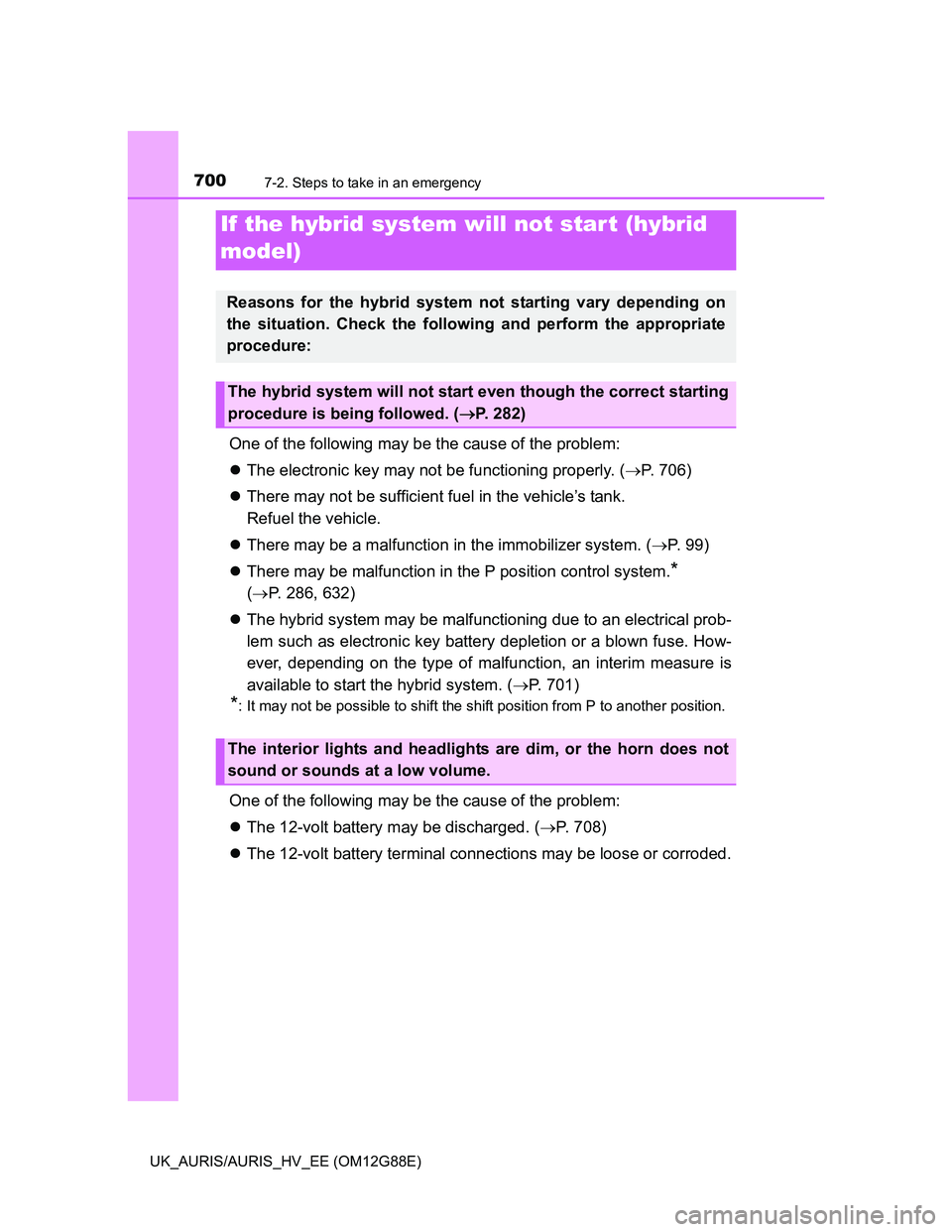
7007-2. Steps to take in an emergency
UK_AURIS/AURIS_HV_EE (OM12G88E)
One of the following may be the cause of the problem:
The electronic key may not be functioning properly. (P. 706)
There may not be sufficient fuel in the vehicle’s tank.
Refuel the vehicle.
There may be a malfunction in the immobilizer system. (P. 9 9 )
There may be malfunction in the P position control system.
*
(P. 286, 632)
The hybrid system may be malfunctioning due to an electrical prob-
lem such as electronic key battery depletion or a blown fuse. How-
ever, depending on the type of malfunction, an interim measure is
available to start the hybrid system. (P. 701)
*: It may not be possible to shift the shift position from P to another position.
One of the following may be the cause of the problem:
The 12-volt battery may be discharged. (P. 708)
The 12-volt battery terminal connections may be loose or corroded.
If the hybrid system will not star t (hybrid
model)
Reasons for the hybrid system not starting vary depending on
the situation. Check the following and perform the appropriate
procedure:
The hybrid system will not start even though the correct starting
procedure is being followed. (P. 282)
The interior lights and headlights are dim, or the horn does not
sound or sounds at a low volume.
Page 701 of 788
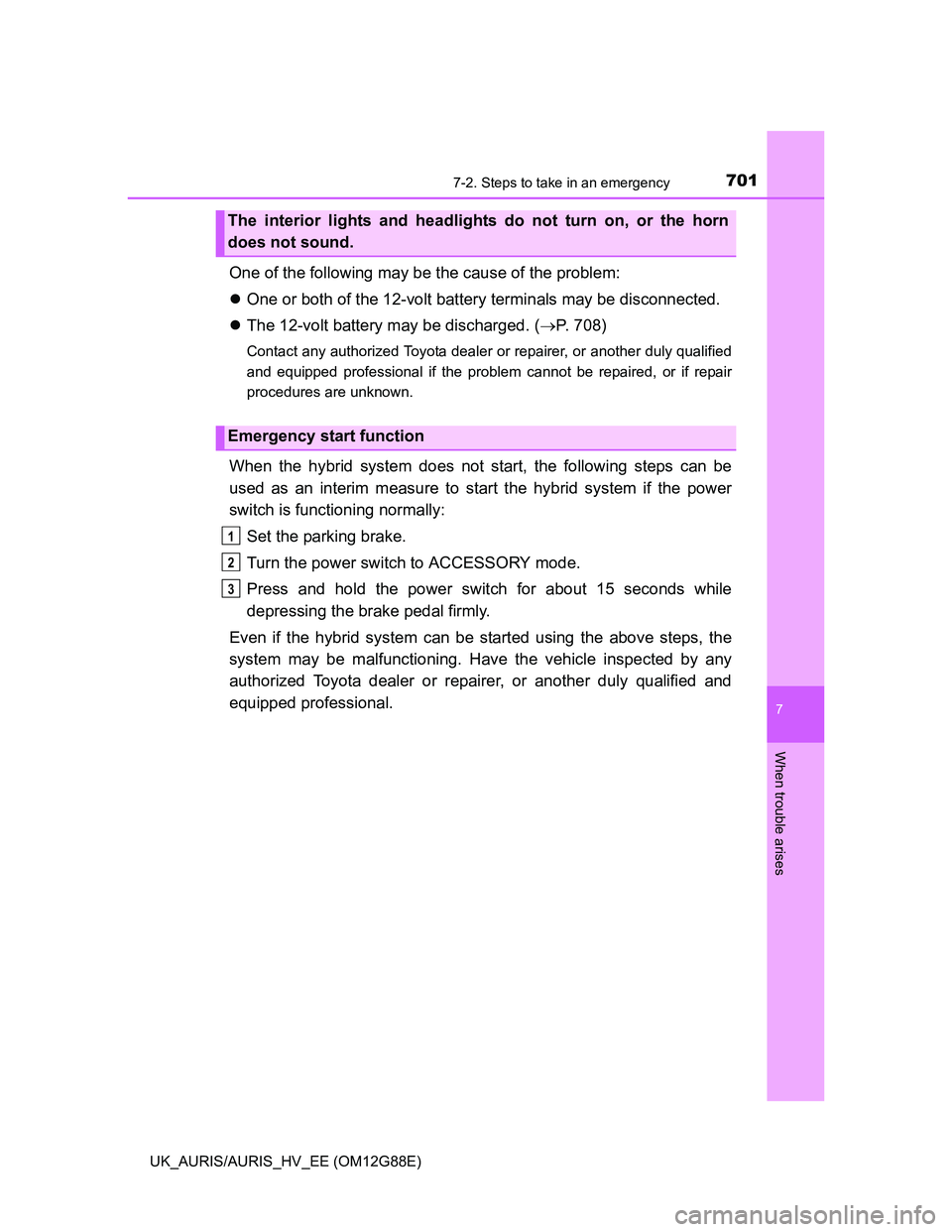
7017-2. Steps to take in an emergency
UK_AURIS/AURIS_HV_EE (OM12G88E)
7
When trouble arises
One of the following may be the cause of the problem:
One or both of the 12-volt battery terminals may be disconnected.
The 12-volt battery may be discharged. (P. 708)
Contact any authorized Toyota dealer or repairer, or another duly qualified
and equipped professional if the problem cannot be repaired, or if repair
procedures are unknown.
When the hybrid system does not start, the following steps can be
used as an interim measure to start the hybrid system if the power
switch is functioning normally:
Set the parking brake.
Turn the power switch to ACCESSORY mode.
Press and hold the power switch for about 15 seconds while
depressing the brake pedal firmly.
Even if the hybrid system can be started using the above steps, the
system may be malfunctioning. Have the vehicle inspected by any
authorized Toyota dealer or repairer, or another duly qualified and
equipped professional.
The interior lights and headlights do not turn on, or the horn
does not sound.
Emergency start function
1
2
3
Page 705 of 788

7057-2. Steps to take in an emergency
UK_AURIS/AURIS_HV_EE (OM12G88E)
7
When trouble arises
Multidrive: Ensure that the shift lever is in P and depress the brake
pedal.
Multi-mode manual transmission: Ensure that the shift lever is in N
and depress the brake pedal.
Manual transmission: Shift the shift lever to N and depress the
clutch pedal.
Touch the Toyota emblem side
of the electronic key to the
engine switch.
When the electronic key is
detected, a buzzer sounds and the
engine switch will turn to IGNITION
ON mode.
When the smart entry & start sys-
tem is deactivated in customization
setting, the engine switch will turn
to ACCESSORY mode.
Vehicles without a multi-information display: Firmly depress the
brake pedal (Multidrive or multi-mode manual transmission) or
clutch pedal (manual transmission) and check that the smart entry
& start system indicator light (green) turns on.
Vehicles with a multi-information display: Firmly depress the brake
pedal (Multidrive or multi-mode manual transmission) or clutch
pedal (manual transmission) and check that is shown on the
multi-information display.
Press the engine switch.
In the event that the engine still cannot be started, contact any autho-
rized Toyota dealer or repairer, or another duly qualified and equipped
professional.
Starting the engine (except hybrid model)
1
2
3
4
Page 711 of 788
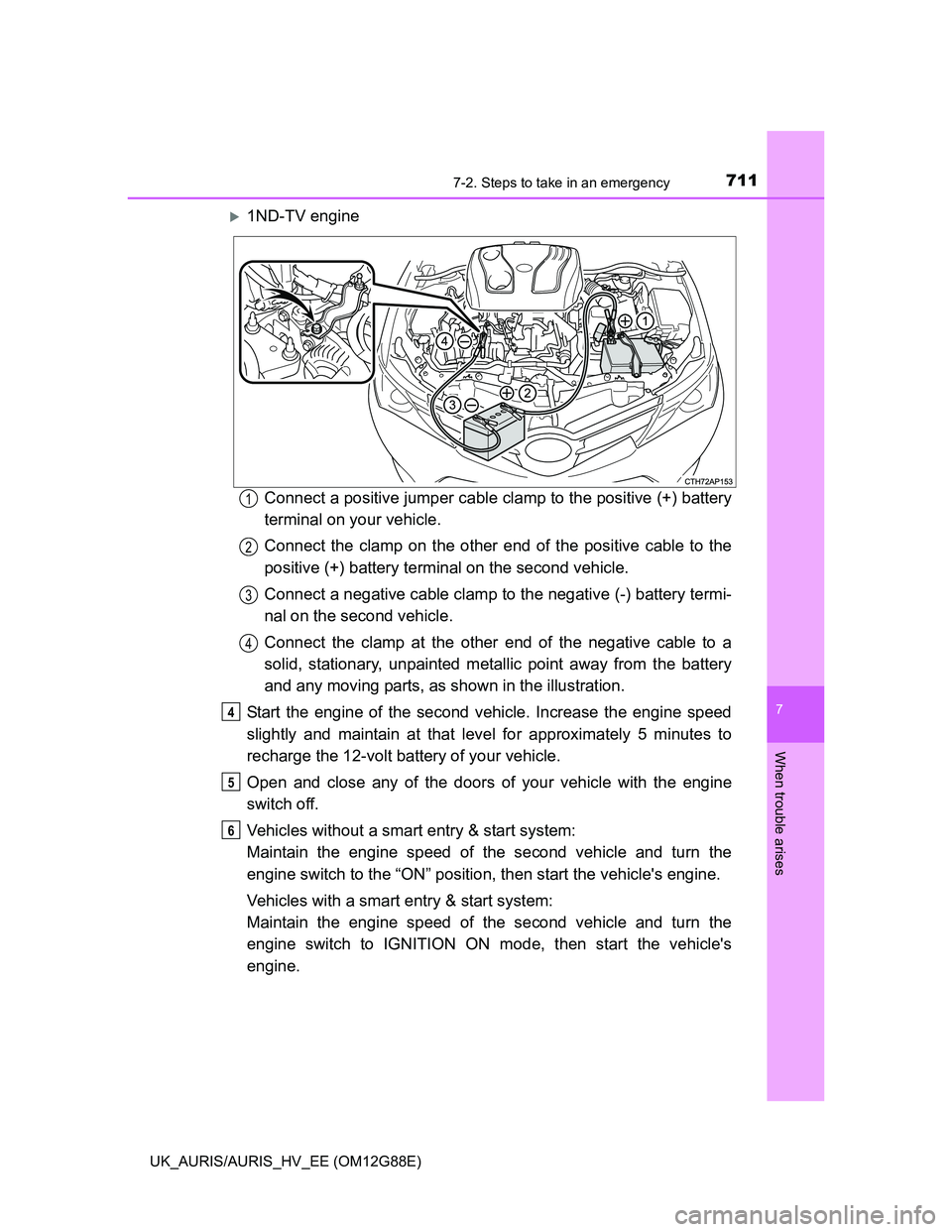
7117-2. Steps to take in an emergency
UK_AURIS/AURIS_HV_EE (OM12G88E)
7
When trouble arises
1ND-TV engine
Connect a positive jumper cable clamp to the positive (+) battery
terminal on your vehicle.
Connect the clamp on the other end of the positive cable to the
positive (+) battery terminal on the second vehicle.
Connect a negative cable clamp to the negative (-) battery termi-
nal on the second vehicle.
Connect the clamp at the other end of the negative cable to a
solid, stationary, unpainted metallic point away from the battery
and any moving parts, as shown in the illustration.
Start the engine of the second vehicle. Increase the engine speed
slightly and maintain at that level for approximately 5 minutes to
recharge the 12-volt battery of your vehicle.
Open and close any of the doors of your vehicle with the engine
switch off.
Vehicles without a smart entry & start system:
Maintain the engine speed of the second vehicle and turn the
engine switch to the “ON” position, then start the vehicle's engine.
Vehicles with a smart entry & start system:
Maintain the engine speed of the second vehicle and turn the
engine switch to IGNITION ON mode, then start the vehicle's
engine.
1
2
3
4
4
5
6